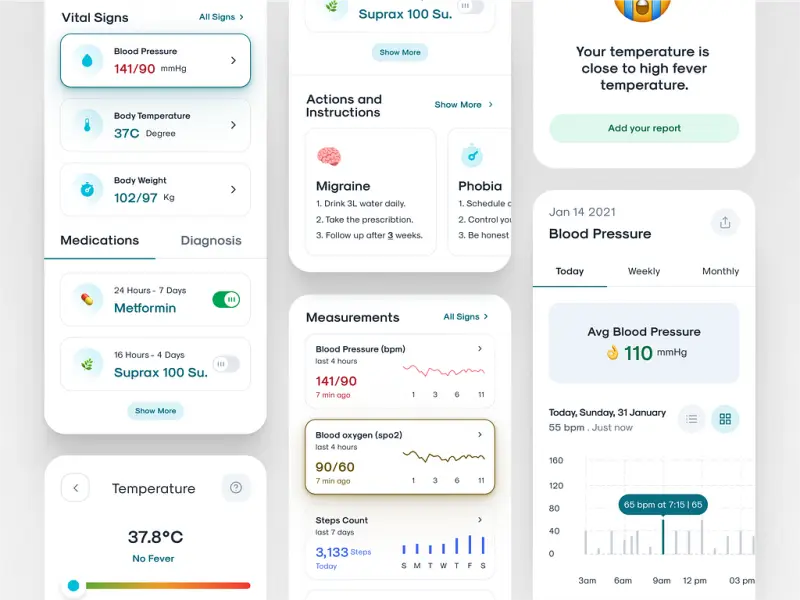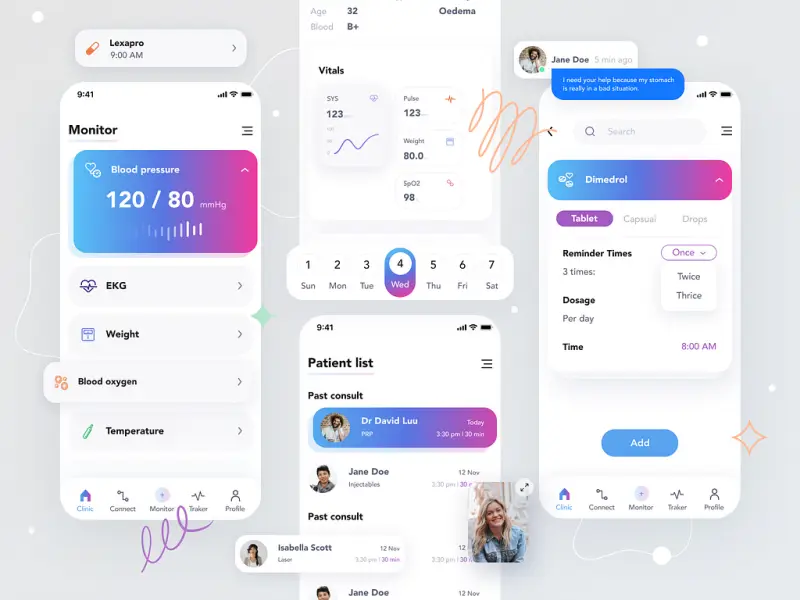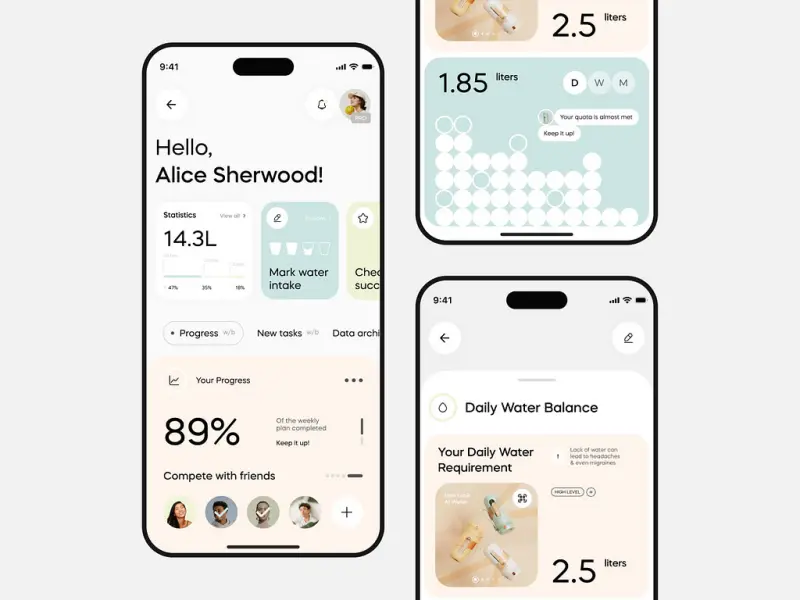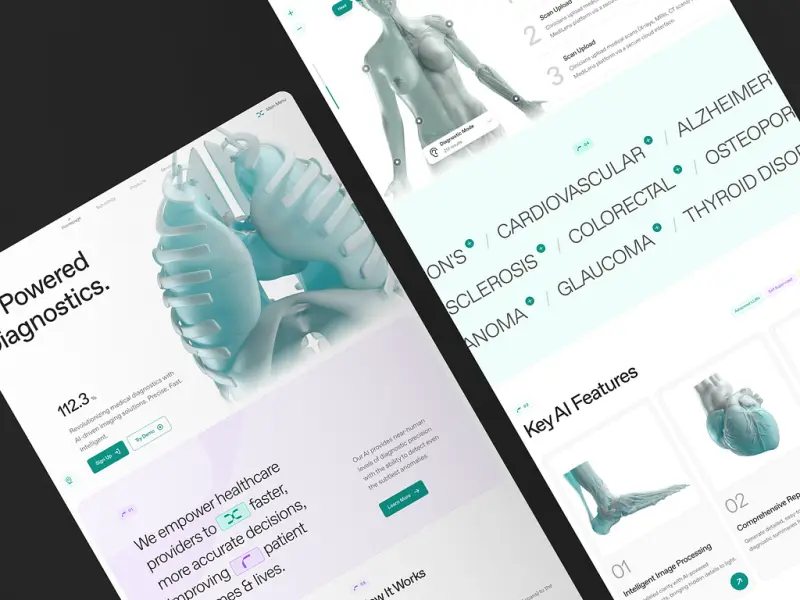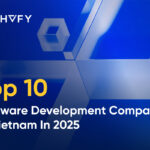Remote Patient Monitoring Software: The Full Guide in 2025
- TECHVIFY Team
- January 7, 2025
- Knowledge, Guides
- 0 Comments
Not long ago, patients diagnosed with chronic conditions faced the burden of frequent hospital visits to manage their health. These visits often disrupted their daily lives and placed a strain on healthcare systems. Fast forward to today, and remote patient monitoring software has transformed how healthcare is delivered. By enabling high-risk patients to receive care from the comfort of their homes, remote patient monitoring applications are redefining patient management and improving outcomes.
In recent years, the healthcare industry has witnessed a remarkable shift toward digital solutions, with remote patient monitoring (RPM) leading the charge. In 2023, over 81% of clinicians were using RPM tools, representing a staggering 305% increase from 2021. From wearables to advanced devices like ECG monitors and pulse oximeters, the adoption of RPM technology is reshaping healthcare delivery.
Let’s dive into the potential, challenges, and development workflow of remote patient monitoring software to understand how this innovative technology is shaping the future of healthcare.
I. Benefits of Developing Remote Patient Monitoring Software
Below, we’ll explore the key benefits of developing RPM software and why it’s essential in today’s evolving healthcare landscape.
Remote patient monitoring applications
Improved Access to Care
Remote patient monitoring applications bring healthcare to patients, no matter where they are. This accessibility is a game-changer for individuals in remote areas or those with limited mobility. For instance, 65% of doctors in both urban and rural areas now utilize RPM tools for medical management, ensuring that patients receive the care they need without barriers.
For at-risk populations—such as the elderly or immunocompromised—RPM technology serves as a lifeline. Patients can monitor their health conditions from the comfort of their homes, reducing the need for frequent hospital visits and minimizing exposure to potential health risks.
Still want to see more Healthcare articles? Check here:
Early Detection of Health Issues
Remote patient monitoring software enables healthcare providers to track patient health metrics in real-time, allowing for early intervention when signs of deterioration appear. This makes the best remote patient monitoring software invaluable in preventing complications. For example, AI-powered RPM solutions can analyze patient data and alert care teams when a diabetic patient’s blood sugar levels become dangerously high. By catching health problems early, RPM systems help prevent complications, improve patient outcomes, and reduce the strain on healthcare facilities.
Reduced Hospital Readmissions
Remote patient monitoring minimizes avoidable hospitalizations by addressing minor health issues before they escalate. Hospitals can discharge patients earlier while maintaining oversight of their recovery through RPM tools. For instance, the University of Pittsburgh Medical Center reduced hospital readmissions by 76% by equipping patients with RPM devices and tablets. These tools allow clinicians to monitor recovery remotely, freeing up hospital beds for more critical cases.
Personalization of Care
RPM systems facilitate personalized treatment plans by analyzing patient-generated health data and integrating it with electronic health records (EHRs). This allows healthcare providers to make targeted adjustments to medication dosages, treatment protocols, or lifestyle recommendations. For example, in long-term care settings, RPM data can help adjust rehabilitation regimens or medication schedules in real-time, ensuring patients receive the most effective care for their specific needs.
Enhanced Chronic Disease Management
Managing chronic conditions like diabetes, hypertension, or heart disease requires continuous monitoring and communication. RPM tools streamline this process by enabling seamless sharing of vital metrics between patients, healthcare providers (HCPs), and specialists. This fosters collaboration, improves adherence to treatment plans, and provides a clearer picture of a patient’s progress between in-person visits.
Reduced Healthcare Costs
RPM technology not only saves lives but also significantly reduces healthcare costs. Over the next 25 years, RPM is projected to save $200 billion globally by enabling:
- Early interventions to prevent costly complications.
- Lower hospital readmission rates.
- Efficient chronic disease management.
- Reduced workload for doctors and healthcare teams.
By optimizing resource allocation and minimizing unnecessary expenses, RPM solutions make healthcare more sustainable and cost-effective.
Increased Patient Engagement and Satisfaction
Empowering patients to take an active role in their health is a hallmark of RPM. Studies show that 40% of individuals with chronic conditions want greater involvement in managing their health. RPM tools deliver on this by providing patients with real-time access to their health data, medication reminders, and educational resources. This increased engagement leads to:
- Better adherence to treatment plans.
- Healthier lifestyle choices.
- A stronger sense of ownership over personal well-being.
As a result, patients experience higher satisfaction levels and better health outcomes.
Optimized Resource Allocation
RPM systems streamline healthcare workflows by automating data collection, analysis, and reporting. This eliminates the need for manual data entry, giving providers more time to focus on critical tasks. Additionally, hospital-at-home initiatives supported by RPM technology ensure that in-person resources are prioritized for patients who need immediate intervention.
Have a Project Idea in Mind?
Get in touch with experts for a free consultation. We’ll help you decide on next steps, explain how the development process is organized, and provide you with a free project estimate.
II. Remote Patient Monitoring (RPM) Development Process in 6 Steps
Developing remote patient monitoring (RPM) software is a collaborative and multi-stage process that transforms a product idea into a fully functional, secure, and user-friendly platform. By following a structured development process, you can ensure that your RPM solution meets regulatory requirements, addresses user needs, and integrates seamlessly with healthcare systems. Below, we break down the RPM software development process into six essential steps.
Step 1: Requirement Collection and Analysis
The foundation of any successful RPM project lies in understanding its goals and requirements. At this stage, your software development team works with you to refine your product vision and fill in any knowledge gaps, ensuring your project results in the best remote patient monitoring software.
Key Activities:
- Collaborate with stakeholders to define project goals and target health conditions.
- Identify the core functionalities of the RPM software (e.g., real-time data monitoring, alerts, telehealth integration).
- Select an optimal tech stack and plan the app’s architecture.
- Design integration strategies for other healthcare systems like Electronic Health Records (EHRs), ensuring seamless data flow.
Outcome: A clear roadmap for development, including prioritized features and technical specifications.
Software for remote patient monitoring
Step 2: Outlining Security and Compliance Requirements
Healthcare data is highly sensitive and subject to strict regulations, such as HIPAA (Health Insurance Portability and Accountability Act) in the US and GDPR (General Data Protection Regulation) in Europe. Ensuring compliance and data security from the start is critical to avoid legal and operational risks.
Key Activities:
- Implement audit trail capabilities to track data access and changes.
- Choose strong encryption protocols for protecting data at rest and in transit.
- Select secure, compliant cloud storage solutions to safeguard patient information.
- Define an API strategy to enable secure communication between IoMT (Internet of Medical Things) devices, backend systems, and client applications.
- Develop a robust testing strategy for pre- and post-production releases to verify compliance.
Outcome: A secure and compliant development framework designed to protect sensitive healthcare data.
Step 3: Prototyping and Design
The design phase prioritizes creating an intuitive, user-friendly interface that meets the needs of patients, healthcare providers, and other stakeholders. By gathering feedback early, you can ensure your remote patient monitoring software delivers on usability and accessibility.
Key Activities:
- Conduct user research to define user personas and map their journeys.
- Create a low-fidelity prototype that outlines the platform’s basic structure and functionality.
- Gather stakeholder and user feedback on the prototype’s look and feel.
- Refine the design based on feedback, emphasizing a clean, accessible interface (e.g., high contrast for visually impaired users, multilingual support).
- Finalize polished design layouts and share them with the development team as a reference.
Outcome: A refined prototype and finalized interface design that balances functionality and user experience.
Step 4: Development and Integration
With the design approved, the development phase begins. This iterative process focuses on building a robust system while ensuring compliance with regulatory standards.
Key Activities:
- Develop the frontend and backend of the platform, ensuring responsiveness and scalability.
- Create mobile applications for patients and doctor-facing interfaces for healthcare providers.
- Integrate the RPM system with IoMT devices and external healthcare systems (e.g., EHRs).
- Implement functionalities like real-time health tracking, alerts, and messaging.
Outcome: A fully functional RPM system built with healthcare-grade reliability and regulatory compliance.
Step 5: Testing
Testing is critical in RPM development, as even minor issues can disrupt patient care. The testing phase ensures that the software is stable, secure, and compatible with IoMT devices.
Key Activities:
- Conduct functional testing to verify that all features work as intended.
- Perform compatibility testing to ensure seamless integration with IoMT devices and other systems.
- Test for security vulnerabilities and compliance with healthcare regulations.
- Conduct user acceptance testing (UAT) with real-world users to validate the platform’s usability.
Outcome: A thoroughly tested RPM system that delivers a seamless experience for patients and healthcare providers.
Step 6: Ongoing Improvements
The development process doesn’t end with deployment. Continuous monitoring and updates are essential to maintain system performance, enhance features, and ensure long-term success.
Key Activities:
- Monitor the system’s performance post-launch to identify and resolve issues quickly.
- Provide training materials and support for patients and healthcare providers to facilitate adoption.
- Implement a roadmap for regular software updates to improve functionality, security, and user experience.
- Gather user feedback to prioritize enhancements and stay aligned with evolving healthcare needs.
Outcome: A continuously optimized RPM system that adapts to user needs and technological advancements.
Key Features of an Effective Remote Patient Monitoring Solution
When developing RPM software, it’s crucial to build a solution that not only monitors health metrics but also enhances the overall healthcare experience. Here are the six core features every RPM platform should include:
Real-Time Patient Health Tracking
RPM systems should enable continuous or periodic data collection from medical devices. Technologies like wearables, IoT, and cloud computing work together to ensure seamless health monitoring. Key capabilities include:
- Integration with devices like smartwatches, glucometers, and blood pressure monitors.
- Wireless transmission of health data to a secure cloud platform.
- Real-time processing and sharing of health insights with healthcare providers.
Remote patient monitoring software
Data Analytics and Reporting
An effective RPM solution doesn’t just collect data—it makes sense of it. By leveraging machine learning and data visualization tools, RPM platforms can provide actionable insights, such as:
- Early detection of potential health issues.
- Alerts for abnormal biometric readings.
- Historical trend analysis to identify unusual patterns.
- Automated reports summarizing patient health metrics.
These features allow providers to adopt proactive care strategies and optimize workflows.
IoT-Based Monitoring
Integrating RPM systems with IoT devices enhances the scope of remote care. For example, combining data from a smartwatch (heart rate) with a glucometer (blood sugar) and a blood pressure cuff provides a comprehensive view of a diabetic patient’s health. IoT-based monitoring also simplifies:
- Device configuration.
- Identification of technical issues or device failures.
Accessibility Features
To ensure inclusivity, RPM platforms must incorporate features that cater to diverse patient needs, such as:
- Voice control for patients with motor impairments.
- Text-to-speech for those with visual impairments or dyslexia.
- User-friendly design, including screen reader compatibility, high-contrast modes, and multilingual support.
By adhering to accessibility guidelines like WCAG and CVAA, RPM solutions can serve non-tech-savvy and disabled users effectively.
Patient-Doctor Online Communication
Combining RPM with telemedicine capabilities strengthens patient-provider relationships. Essential features include:
- Secure video conferencing for virtual consultations.
- Messaging tools for updates, scheduling, and treatment adjustments.
- Educational resources tailored to specific health conditions.
- Engagement tools, such as medication reminders and health quizzes.
These features ensure continuous, two-way communication, fostering better care.
Remote Prescription Management
RPM platforms can streamline the prescription process by enabling virtual prescription management. Patients can request refills or adjust medications without needing to visit a clinic, saving time for both parties.
Let’s talk
A consultation with the Client Relationship Manager, who represents TECHVIFY, without any commitment from your side, will give you:
- Structured and clear vision of your future application
- Information about how our software development company guarantees 100% on-time and on-budget delivery
- Recommendations for choosing the tech stack
- Advice on further steps
- Business-side recommendations
- Rough project estimation on software development
TECHVIFY is right where you need. Contact us now for further consultation:
III. In-Demand Types of Remote Patient Monitoring (RPM) Software
As remote patient monitoring (RPM) continues to transform the healthcare industry, a variety of RPM software types have emerged to address specific use cases. Below, we’ll explore the most in-demand categories of RPM software and their unique functionalities, providing insights into how they cater to healthcare providers and patients alike.
1. Telehealth Software
Telehealth software bridges the gap between patients and healthcare providers through online communication tools. These platforms typically include features such as video conferencing, secure messaging, and medical file sharing, making them a versatile solution for a wide range of medical specialties.
Key Applications:
- General therapy sessions
- Dermatology consultations
- Ophthalmology evaluations
- Rehabilitation planning
- Second-opinion telemedicine platforms
By enabling virtual consultations and the exchange of medical data, telehealth software ensures that patients can access care from the comfort of their homes while alleviating the burden on healthcare facilities.
2. IoMT-Based Applications
The Internet of Medical Things (IoMT) leverages connected medical devices and wearables to monitor patient health metrics in real time. These applications work seamlessly with devices such as heart rate monitors, blood pressure cuffs, and fitness trackers, offering continuous health monitoring without requiring patients to visit a clinic.
Key Features:
- Embedded software in medical devices or mobile apps for smartphones and tablets
- Real-time data collection and sharing with healthcare providers
- Integration with cloud platforms for secure data storage and analysis
IoMT-based applications are particularly beneficial for managing chronic conditions, as they enable patients and providers to stay connected and informed about health trends.
3. Electronic Data Capture (EDC) Solutions
EDC software collects patient-reported data through online surveys and questionnaires to provide valuable insights into patients’ health conditions. This type of software is often used to track subjective symptoms, such as pain levels or mental health concerns, helping clinicians develop more personalized treatment plans.
Key Benefits:
- Simplifies data collection from patients
- Encourages self-assessment and awareness of health conditions
- Enables clinicians to analyze trends in patient-reported outcomes
Custom EDC solutions can be tailored to specific healthcare needs, making them a versatile tool for both clinical trials and routine patient care.
4. Combined RPM Applications
Combined RPM solutions bring together the functionalities of telehealth, IoMT, and EDC software into a single, cohesive platform. These systems are highly customizable, allowing developers to create software tailored to specific medical specialties or business goals.
Advantages:
- Streamlined user experience for patients and providers
- Centralized data collection and analysis
- Flexibility to incorporate additional features, such as prescription management or educational resources
By integrating multiple capabilities, combined RPM applications deliver a comprehensive approach to remote care.
Still want to see more Healthcare articles? Check here:
IV. Best Examples of RPM Software on the Market
To create a standout RPM solution, it’s essential to learn from the success of established platforms. Below are some of the top RPM software solutions currently on the market, along with what makes them unique.
5 Best remote patient monitoring softwares
1. Dexcom
Dexcom specializes in continuous glucose monitoring (CGM) systems, offering both hardware and software solutions to help diabetes patients manage their condition.
What’s Unique?
- The Dexcom G6 CGM system includes a wearable sensor and transmitter that sends glucose levels to a smartphone app.
- Patients can share their glucose data with up to 10 people, keeping family and healthcare providers informed.
- Dexcom Clarity provides visual data analysis, helping clinicians adjust treatment plans based on trends in blood glucose levels.
Dexcom focuses exclusively on diabetes management, offering a user-friendly and highly specialized RPM solution.
2. Medtronic
With over 70 years of experience, Medtronic is a leader in healthcare technology, offering a broad range of RPM tools for monitoring vital signs and health indicators.
What’s Unique?
- Medtronic’s RPM apps work with devices like weight scales, blood pressure monitors, and glucometers.
- The Medtronic Care Management Services platform alerts providers when patients exceed predefined thresholds, enabling early intervention.
- The platform supports trend analysis, allowing providers to modify care plans based on real-time data.
Medtronic’s comprehensive approach makes it a versatile solution for various medical conditions.
3. Doctolib
Originally a scheduling platform, Doctolib has evolved into a telemedicine powerhouse, connecting patients with healthcare providers in France and Germany.
What’s Unique?
- Patients can book remote appointments with doctors they’ve seen in person within the past 12 months.
- The platform includes video chat capabilities and online prescription access.
- Doctolib focuses on enhancing the daily lives of healthcare professionals and patients while fostering entrepreneurship.
Doctolib’s marketplace model makes it a standout in the European telemedicine space.
4. Philips
Philips offers patient-centered RPM solutions designed to improve health outcomes while reducing financial strain on healthcare providers and patients.
What’s Unique?
- The eCareCoordinator dashboard for clinicians and eCareCompanion app for patients work together to track and analyze health data.
- Patients can upload data from connected devices, such as blood glucose meters, and receive insights into their health trends.
- Clinicians can customize care plans and collaborate with other physicians through the platform.
Philips’ focus on empowering healthier behaviors and reducing costs makes it a valuable addition to any healthcare system.
5. Senseonics
Senseonics develops long-term, implantable CGM systems that improve diabetes management with precision and ease.
What’s Unique?
- The system includes a sensor implanted under the skin and a removable transmitter that connects to a mobile app.
- Patients receive alerts when their glucose levels are too high or too low.
- The app provides trend analysis and allows data sharing with family members and healthcare providers.
By combining innovative hardware with user-friendly software, Senseonics delivers a cutting-edge RPM solution for diabetes patients.
Conclusion
Remote patient monitoring software has revolutionized how healthcare providers deliver care, offering real-time insights, improved patient outcomes, and reduced operational costs. However, creating a secure, compliant, and user-friendly RPM platform requires more than just an idea—it demands the right expertise to build the best remote patient monitoring software tailored to your needs.
At TECHVIFY, we specialize in developing custom RPM solutions tailored to your unique needs. From streamlining chronic care management to enhancing patient engagement and ensuring regulatory compliance, we’ll help you build a solution that delivers measurable value for both your patients and your organization.
Contact TECHVIFY for a free consultation today and let’s transform your vision into an RPM system that drives better care, smarter workflows, and sustainable growth.
TECHVIFY – Global AI & Software Solution Company
From Startups to Industry Leaders: TECHVIFY prioritizes results, not just deliverables. Accelerate your time to market and see ROI early with high-performing teams, AI (including GenAI) Software Solutions, and ODC (Offshore Development Center) services.
- Email: [email protected]
- Phone: (+84)24.77762.666




